How to find the most suitable sensor for your SPR application
Are you unsure of which type of sensor is best for your Surface Plasmon Resonance? Look no further.
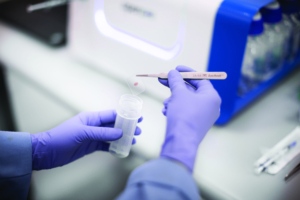
In this article, we will cover the different types of SPR Sensors, the advantages of Covalent Coupling, Capture Coupling and Hydrophobic Capturing to help you determine which sensor is best for your application.
But before diving deeply into the world of sensors, we want to make sure that you’re familiar with Surface Plasmon Resonance or SPR.
What is SPR?
SPR is a label-free technique that allows you to gain in-depth knowledge of how two biomolecules interact. The process takes place on a sensor inside of an instrument such as the OpenSPR or Alto from Nicoya. Usually, researchers use SPR instruments to measure binding affinity and kinetics.
In recent years, the equipment have become more cost-efficient and accessible. This is because the SPR brings valuable data to researcher's work.
In recent years, the equipment have become more cost-efficient and accessible. This is because the SPR brings valuable data to researcher's work.
In a typical SPR assay, you must immobilize one of your binding partners onto the surface of the sensor. We refer to the immobilized molecule as the ligand. The sensor pre-functionalized with a particular surface chemistry. This is to ease the immobilization of your ligand.
This way, it interacts with your other binding partner (also known as the analyte). You now have a system that can output valuable data on how the two molecules interact.
This way, it interacts with your other binding partner (also known as the analyte). You now have a system that can output valuable data on how the two molecules interact.

Before you start your experiment, it is important to determine which sensor is most suitable for your specific application. The choice you make very much depends on your specific ligand. This is because there are three major ways of immobilizing ligands on your sensor.
The major techniques are covalent coupling, capture coupling, and hydrophobic capturing. In the following, we will guide you through the different techniques. Here, we will help you find the best-suited sensor for your experient.
The major techniques are covalent coupling, capture coupling, and hydrophobic capturing. In the following, we will guide you through the different techniques. Here, we will help you find the best-suited sensor for your experient.
The Types of SPR Sensors
Sensors consist of three things: a glass substrate, gold nanoparticles, and a certain functional chemical coating. This allows the ligand to be immobilized to the sensor surface. Choosing the right sensor depends on the characteristics of your ligand.
Ask yourself the following questions
- Is it tagged or untagged?
- Does it have any functional groups?
- Is it an IgG-based antibody?
- Is it a lipid or a protein reconstituted into a liposome?
Regardless of the sensor chemistry, there are generally inherited benefits to using SPR sensors. One is the reusability. The number of times you can reuse a sensor with the ligand attached depends on the stability of the ligand. Nicoya is a front-runner in the fields of nanotechnology, biochemistry, and optical sensors.
They have developed some high-quality yet affordable sensors.
They have developed some high-quality yet affordable sensors.
We recommend the following
Covalent coupling sensors
- Carboxyl – for coupling to activated amine groups on the ligand
- Amine – for coupling to activated carboxyl groups on the ligand
- Gold – no surface chemistry; for custom surface chemistry development and direct immobilization of ligands with thiol groups
Capture coupling sensors
- Biotin-Streptavidin Sensor Kit – for coupling to biotinylated ligands
- Biotin – for coupling to streptavidin-tagged ligands
- NTA – for coupling to his-tagged ligands
- Protein A Sensor Kit – for coupling to IgG based antibodies
Hydrophobic capture sensors
- Liposome – for coupling liposomes
- Hydrophobic – for lipid monolayer formation
The chart below may help you determine what sensor to use for your applications
Sensor | For the immobilization of
Carboxyl | Any amine group using EDC/NHS coupling
Amine | Any carboxyl group using EDC/NHS coupling
Gold | Non-functionalized and perfect for custom surface chemistry development and targets with thiol groups
Biotin-Streptavidin Sensor Kit | Biotinylated ligands
Biotin | Streptavidin-tagged ligands
NTA | Histidine-tagged targets
Protein ASensor Kit | IgG based antibodies
Liposome | Liposomes/membrane proteins
Hydrophobic | Lipid monolayer formation
Covalent Coupling – SPR Sensors
Using a standard covalent interaction, covalent coupling irreversibly attaches the ligand to the sensor’s surface.
Why we recommend it
- Reduces ligand dissociation
- Maintains the binding capacity throughout the experiment(s) (provided that the ligand is stable)
- Compatible with most biomolecules, which minimizes the need for chemical or genetic modifications to the ligan
1. Carboxyl Sensors
Carboxyl sensors need EDC/NHS chemistry to activate the functional groups on the sensor surface. This can then bind to the ligand’s available amine groups or lysine residues. To do so, Nicoya created an activation kit that contains the necessary reagents to perform this coupling.

This coupling method is quite easy to perform as well as staying both consistent and stable.
Yet, one limitation of the method is the orientation of the ligand. The coupling site is not specified, and so it cannot be controlled.
Sometimes the covalent immobilization of the ligand can affect the analyte-ligand interaction.
This is another limitation. If these issues become apparent, we recommend you opt for a capture coupling method instead.
Yet, one limitation of the method is the orientation of the ligand. The coupling site is not specified, and so it cannot be controlled.
Sometimes the covalent immobilization of the ligand can affect the analyte-ligand interaction.
This is another limitation. If these issues become apparent, we recommend you opt for a capture coupling method instead.
2. Amine Sensors
Amine sensors are much like Carboxyl sensors. They also need EDC/NHS chemistry to form the covalent bond between the ligand and the sensor surface. Regardless, the EDC/NHS activation modifies the available carboxyl groups on the ligand.
This may affect its binding activity. So, we generally recommend Carboxyl sensors for protein-ligand immobilization. Amine sensors are commonly used for the immobilization of ligands that contain a carboxylic acid tag that does not take part in the binding interaction.
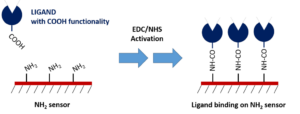
3. Gold Sensors
Researchers use Gold sensors for direct immobilization of ligands containing a thiol group. Either native to the ligand or specifically introduced as a tag, the thiol group will spontaneously form a strong bond with the gold surface.
As the native gold surface is sticky, it is important to block any uncoated gold surface. To do this, you can use short thiolated PEG molecules and BSA after the immobilization of the ligand. This way, you can prevent non-specific binding of the analyte.
Another reason we recommend the Gold sensor is that it is a blank slate. Here, you can develop your own custom sensor chemistry for unique and challenging applications. It also provides an ideal platform for providing a rich teaching environment in undergraduate labs.
Capture Coupling – SPR Sensors
Capture coupling occurs when the ligand is immobilized through a non-covalent interaction with an intermediate capture molecule. This is typically covalently coupled to the surface.
Why we recommend it
- No ligand modification required in some cases
- Ligand orientation is uniform and homogenous
- Capture molecule is specific to the ligand
- Ability to reuse and regenerate the same sensor surface
4 & 5. Biotin/Streptavidin
Biotin and streptavidin have one of the highest affinities of any biomolecular interaction. This makes them an excellent method in immobilization for ligands tagged with streptavidin or biotin. Due to their high affinity, they are reliable as intermediate capture molecules.
They also allow you to withstand regeneration conditions that resemble the nature of covalent capturing and with no background off-rate to affect your data.
You also have the ability to control for ligand orientation. If you are able to tag your molecules with biotin and/or streptavidin, these sensors may be the best for your experiments.

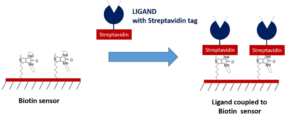
6. NTA Sensors
You can also use nitrilotriacetic acid (NTA). Researchers find this compound suitable for capturing his-tagged ligands. this specific approach contributes to an profitable method of immobilization. That is, if you use poly-histidine (His-6) tags for purification purposes. A great asset to NTA sensors lies within the reusability of the surface.
This is due to the easy removal of the his-tagged. This is done using chelating agents like EDTA. You might find a disadvantage in the lower bond stretch of the coupled ligand. Yet, this depends on your application. It might cause the ligand to gradually dissociate from the sensor.
It may also result in unwanted ligand removal during regeneration. So, if your ligand is his-tagged, you might find it that NTA sensors are more favorable and versatile options.
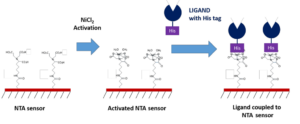
7. Antibody Capture – Carboxyl Sensors
High-affinity antibodies are accessible for numerous proteins. They are commonly used for specific ligand capture. You can perform these methods on a traditional Carboxyl sensor. First, you immobilize the antibody.
Then you use the immobilized antibody to capture your ligand of choice. The most substantial benefit of the antibody coupling technique is that it does not affect ligand activity.
It also allows for specific ligand orientation. The method is also commonly used to capture ligands from complex samples. This allows for a confirmation of the presence of a suspected protein within a crude sample. Yet, you should still consider that regeneration does not ensure the removal of the antibody from the surface.
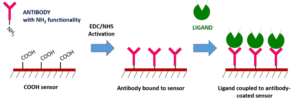
8. Antibody Capture – Protein A Sensor Kit
Protein A Sensors allows you to capture coupling for immobilization of antibody ligands. You can use Protein A to capture the Fc region of IgG antibodies. These allow for directional immobilization of the antibody. That is, where the variable region faces away from the sensor surface. Couple Protein A to a Carboxyl sensor after EDC/NHS activation when you prepare the sensor. This way, you create a Protein A functionalized surface.
The biggest benefit of this technique is the allowance for specific ligand orientation. This is while also creating a stable attachment of your ligand to the sensor surface. The Nicoya Protein A Sensor Kits have the most necessary reagent to prepare your surface. These may be worth looking into if you want to explore working with an antibody ligand.

Hydrophobic Capturing – SPR Sensors
These sensors are designed for use with lipids, membrane systems, or very hydrophobic proteins.
9. Liposome Sensors
Liposomes are a popular tool for examining lipid-lipid and protein-lipid interactions. These offer a simple way of viewing complex biophysical properties of cellular membranes. These sensors consist of lipophilic groups used to capture lipid vesicles.
You may find this method beneficial for examining interactions of membrane proteins. It may also be valuable for other membrane systems, otherwise challenging to study.
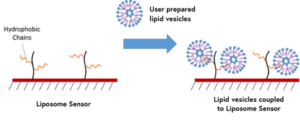
10. Hydrophobic Sensors
Hydrophobic sensors are coated with a hydrophobic layer of long-chain alkane molecules. This allows for the immobilization of lipid molecules for interaction analysis. Partially solubilized lipids will self-assemble into a monolayer with hydrophilic groups positioned away from the surface.
Nicoya's hydrophobic sensors may provide the ideal conditions for your ligands if you are looking at lipid-related interactions.
Nicoya's hydrophobic sensors may provide the ideal conditions for your ligands if you are looking at lipid-related interactions.
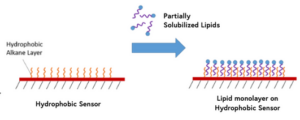
Hopefully, you found this guide helpful! If you are interested in more information or guidance, our team of competent scientists are happy to help you determine which sensor is best for your application.
Want to know more?
Book a call


